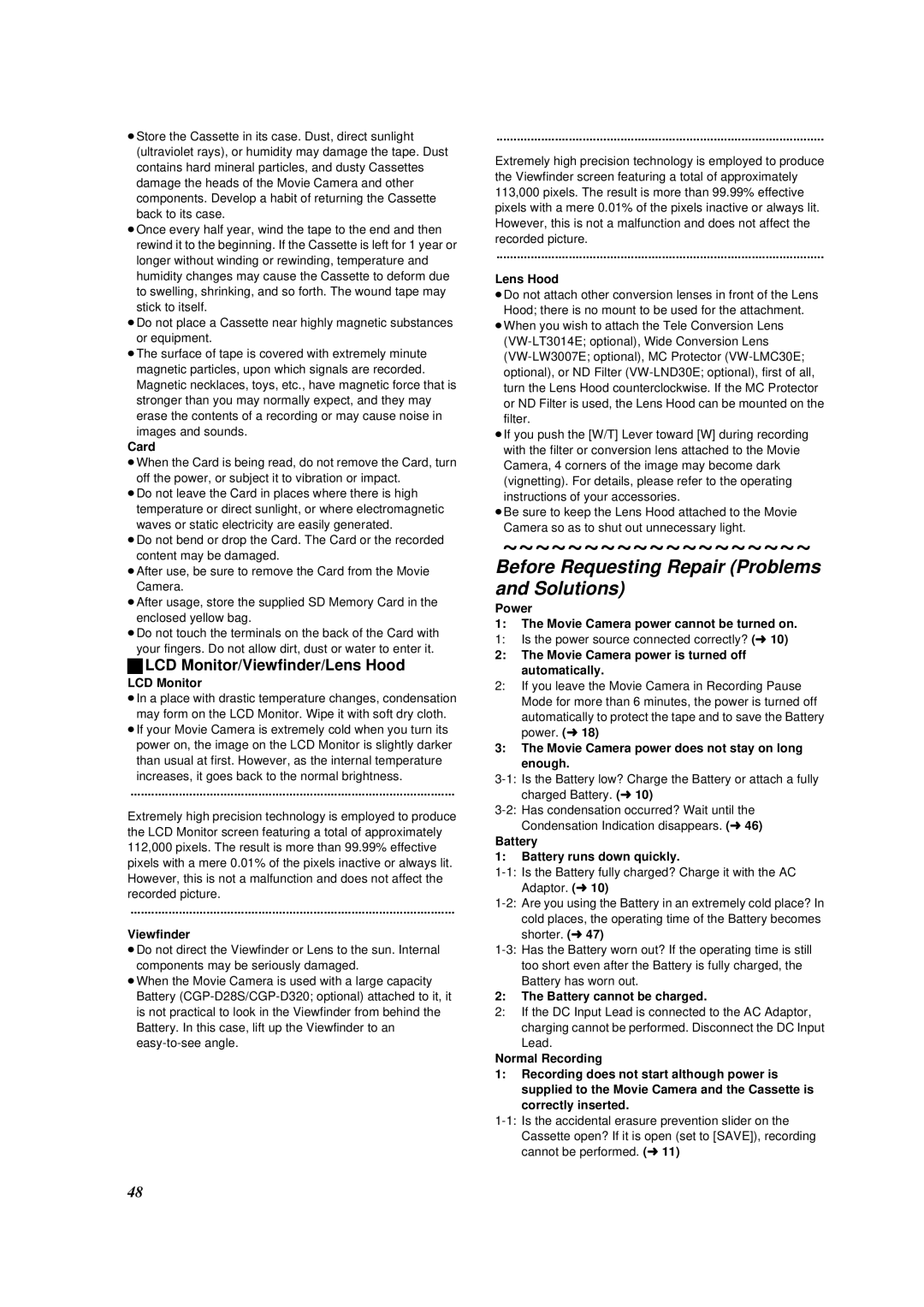≥Store the Cassette in its case. Dust, direct sunlight (ultraviolet rays), or humidity may damage the tape. Dust contains hard mineral particles, and dusty Cassettes damage the heads of the Movie Camera and other components. Develop a habit of returning the Cassette back to its case.
≥Once every half year, wind the tape to the end and then rewind it to the beginning. If the Cassette is left for 1 year or longer without winding or rewinding, temperature and humidity changes may cause the Cassette to deform due to swelling, shrinking, and so forth. The wound tape may stick to itself.
≥Do not place a Cassette near highly magnetic substances or equipment.
≥The surface of tape is covered with extremely minute magnetic particles, upon which signals are recorded. Magnetic necklaces, toys, etc., have magnetic force that is stronger than you may normally expect, and they may erase the contents of a recording or may cause noise in images and sounds.
Card
≥When the Card is being read, do not remove the Card, turn off the power, or subject it to vibration or impact.
≥Do not leave the Card in places where there is high temperature or direct sunlight, or where electromagnetic waves or static electricity are easily generated.
≥Do not bend or drop the Card. The Card or the recorded content may be damaged.
≥After use, be sure to remove the Card from the Movie Camera.
≥After usage, store the supplied SD Memory Card in the
enclosed yellow bag.
≥Do not touch the terminals on the back of the Card with your fingers. Do not allow dirt, dust or water to enter it.
ªLCD Monitor/Viewfinder/Lens Hood
LCD Monitor
≥In a place with drastic temperature changes, condensation may form on the LCD Monitor. Wipe it with soft dry cloth.
≥If your Movie Camera is extremely cold when you turn its power on, the image on the LCD Monitor is slightly darker than usual at first. However, as the internal temperature
increases, it goes back to the normal brightness.
..............................................................................................
Extremely high precision technology is employed to produce the LCD Monitor screen featuring a total of approximately 112,000 pixels. The result is more than 99.99% effective pixels with a mere 0.01% of the pixels inactive or always lit. However, this is not a malfunction and does not affect the recorded picture.
..............................................................................................
Viewfinder
≥Do not direct the Viewfinder or Lens to the sun. Internal components may be seriously damaged.
≥When the Movie Camera is used with a large capacity Battery
...............................................................................................
Extremely high precision technology is employed to produce the Viewfinder screen featuring a total of approximately 113,000 pixels. The result is more than 99.99% effective pixels with a mere 0.01% of the pixels inactive or always lit. However, this is not a malfunction and does not affect the recorded picture.
...............................................................................................
Lens Hood
≥Do not attach other conversion lenses in front of the Lens Hood; there is no mount to be used for the attachment.
≥When you wish to attach the Tele Conversion Lens
≥If you push the [W/T] Lever toward [W] during recording with the filter or conversion lens attached to the Movie Camera, 4 corners of the image may become dark (vignetting). For details, please refer to the operating
instructions of your accessories.
≥Be sure to keep the Lens Hood attached to the Movie Camera so as to shut out unnecessary light.
~~~~~~~~~~~~~~~~~~~
Before Requesting Repair (Problems and Solutions)
Power
1:The Movie Camera power cannot be turned on.
1:Is the power source connected correctly? (l10)
2:The Movie Camera power is turned off
automatically.
2:If you leave the Movie Camera in Recording Pause Mode for more than 6 minutes, the power is turned off automatically to protect the tape and to save the Battery power. (l18)
3:The Movie Camera power does not stay on long
enough.
Battery
1:Battery runs down quickly.
2:The Battery cannot be charged.
2:If the DC Input Lead is connected to the AC Adaptor, charging cannot be performed. Disconnect the DC Input
Lead.
Normal Recording
1:Recording does not start although power is supplied to the Movie Camera and the Cassette is correctly inserted.
48
